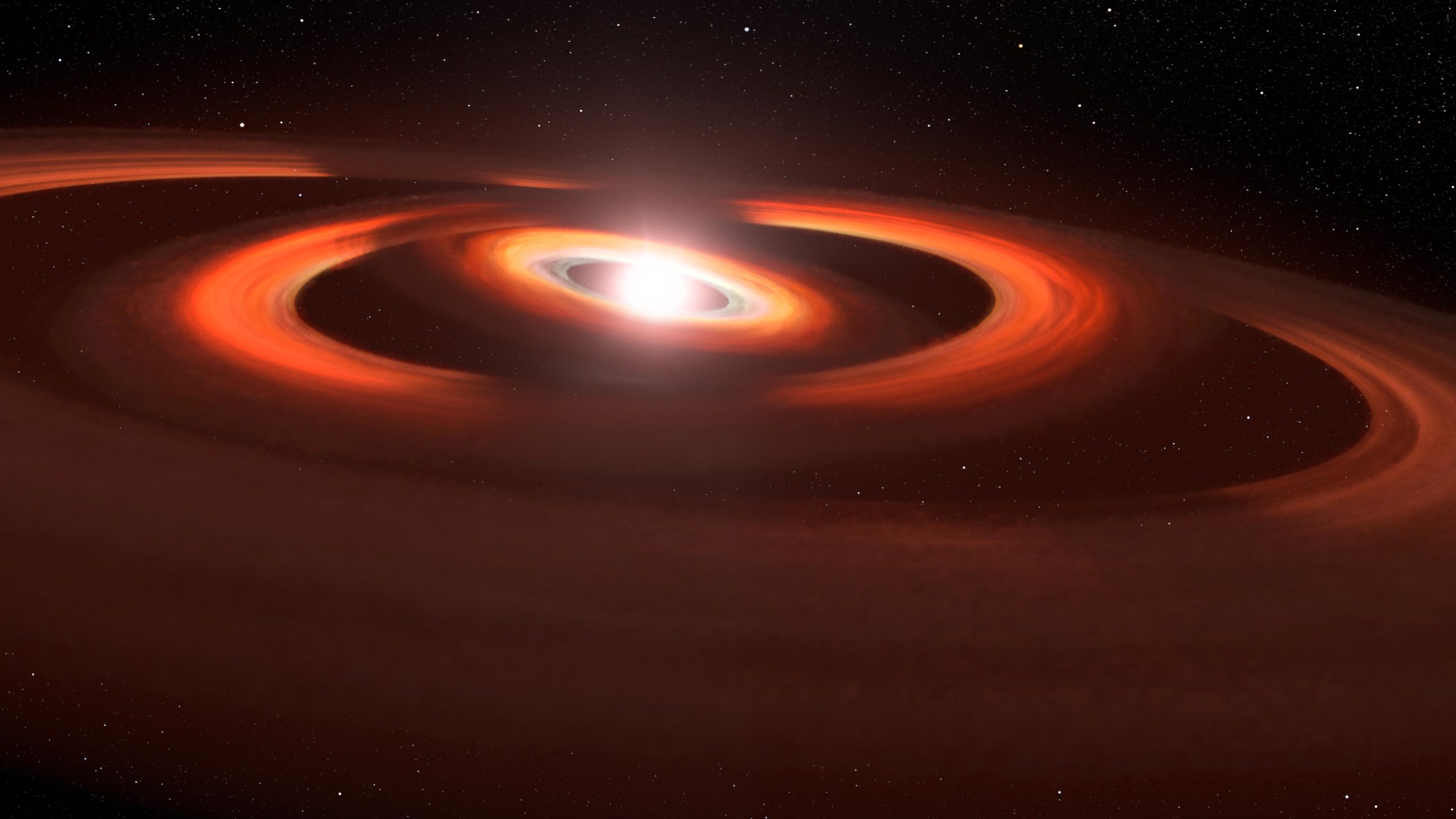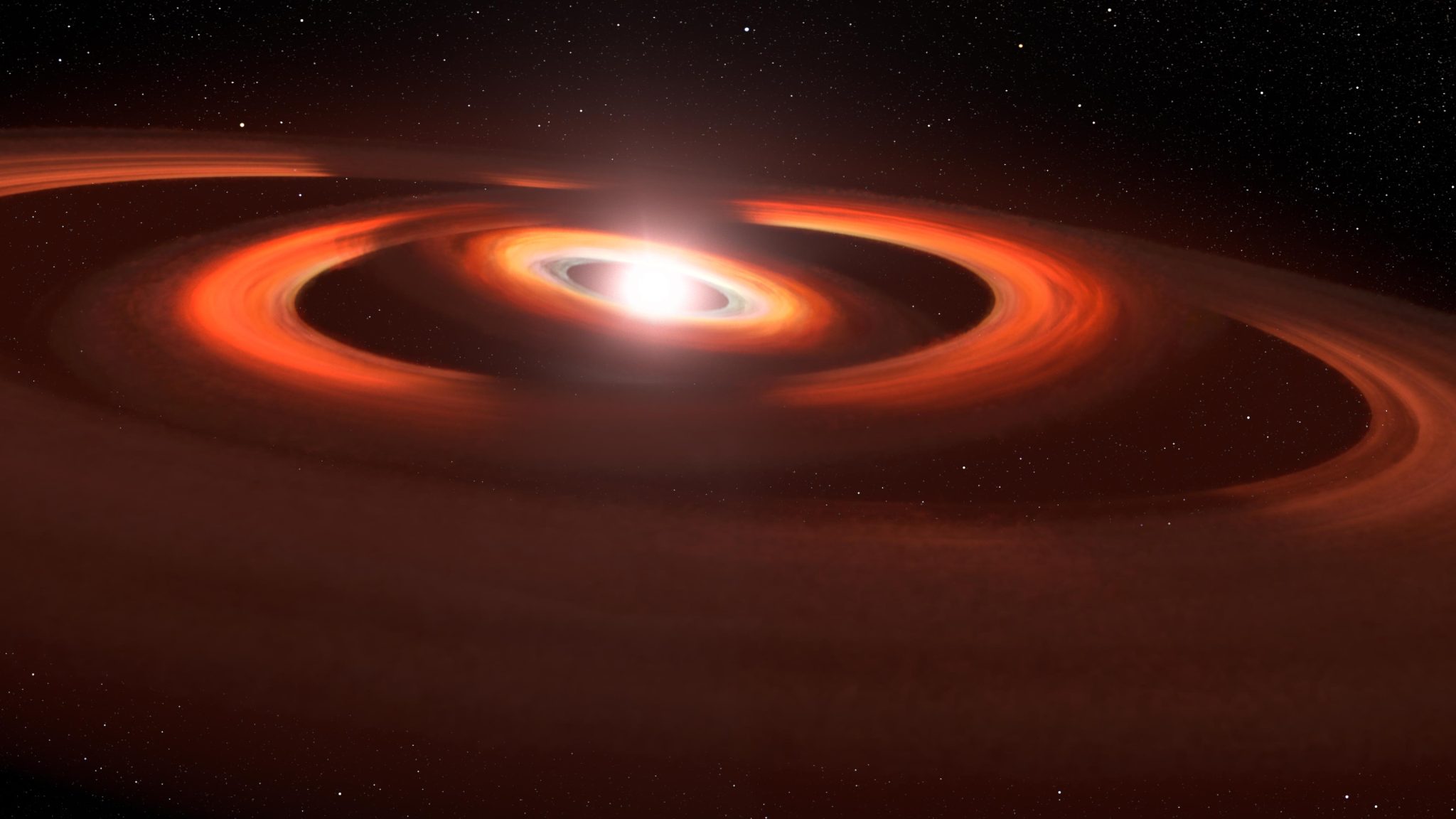

Conceptul acestui artist se bazează pe imaginile telescopului spațial Hubble cu discuri de gaz și praf din jurul tinerei stele TW Hydrae. Imaginile telescopului spațial Hubble arată umbre înghițind discurile care înconjoară sistemul. Explicația este că aceste umbre provin de la discuri interioare ușor înclinate care împiedică lumina stelelor să ajungă la discul exterior, aruncând astfel o umbră. Discurile sunt ușor înclinate unul spre celălalt din cauza forței gravitaționale a planetelor nevăzute care distorsionează structura discului. Credit: NASA, Aura/STScI, Agenția Spațială Europeană, Leah Hostack (STScI)
Planetele nou-născute nevăzute stârnesc praf în jurul unei stele tinere
Lumea noastră este atât de volubilă încât uneori îi place să se joace de-a v-ați ascunselea. În 2017, astronomii au fost surprinși să vadă o umbră uriașă înghițind un disc de praf și gaz care înconjoară tânăra stea din apropiere TW Hydrae. Umbra este proiectată de un disc interior de praf și gaz care este ușor înclinat față de planul discului exterior. Umbra poate fi văzută clar doar pentru că sistemul este înclinat față în față pe Pământ, oferind astronomilor o vedere de pasăre a discului, în timp ce umbra se învârte în jurul discului ca o mână care se mișcă pe un ceas.
Dar ceasul are două mâini (pentru ore și minute) care mătură cu ritmuri diferite. Și se dovedește că și TW Hydrae este. Astronomii au folosit Hubble pentru a găsi o a doua umbră care iese dintr-un alt disc interior, înclinat spre cele două discuri exterioare. Prin urmare, sistemul pare din ce în ce mai complex, cu cel puțin trei discuri suprapuse înclinate ușor unul față de celălalt. Discurile sunt proxy pentru planetele invizibile din jurul stelei. Fiecare planetă trage material în apropierea stelei cu forța sa gravitațională și deformează ceea ce ar fi un disc perfect plat în formă de clătită dacă planetele nu ar fi acolo. Acest lucru nu este surprinzător, deoarece planetele din sistemul nostru solar au plane orbitale care diferă ca înclinare cu câteva grade unele de altele. TW Hydrae le oferă astronomilor un loc lângă ring pentru a vedea cum ar fi putut arăta sistemul nostru solar în anii săi de formare.

Imaginile comparative de la telescopul spațial Hubble, la câțiva ani distanță, au scos la iveală două umbre ciudate care se mișcau în sens invers acelor de ceasornic pe un disc de gaz și praf care înconjoară tânăra stea TW Hydrae. Discurile se înclină față în față pe Pământ, oferindu-le astfel astronomilor o vedere de pasăre a ceea ce se întâmplă în jurul stelei. Fotografia din stânga, făcută în 2016, arată doar o umbră [A] Este ora 11:00. Această umbră este proiectată de un disc interior care este ușor înclinat față de discul exterior și blochează lumina stelelor. Imaginea din stânga arată o a doua umbră care a apărut de pe un alt disc intermediar [C] 7:00 a.m., așa cum a fost filmat în 2021. Disc interior original marcat [B] în această emisiune ulterioară. Umbrele se rotesc în jurul stelei cu viteze diferite, cum ar fi în sensul acelor de ceasornic. Ele sunt dovada a două planete nevăzute care au tras praf în orbitele lor. Acest lucru îi face să se sprijine ușor unul împotriva celuilalt. Aceasta este o imagine în lumină vizibilă realizată cu spectroradiometrul de imagistică al telescopului spațial. Culoarea sintetică a fost adăugată pentru a îmbunătăți detaliile. Credit: NASA, ESA, STScI, John Debes (AURA/STScI pentru ESA), Joseph DePasquale (STScI)
Telescopul spațial Hubble urmărește un joc de umbre în jurul discului care formează planeta
Tânăra vedetă TW Hydrae joacă „păpuși de umbră” cu oamenii de știință care îl urmăresc[{” attribute=””>NASA’s Hubble Space Telescope.
In 2017, astronomers reported discovering a shadow sweeping across the face of a vast pancake-shaped gas-and-dust disk surrounding the red dwarf star. The shadow isn’t from a planet, but from an inner disk slightly inclined relative to the much larger outer disk – causing it to cast a shadow. One explanation is that an unseen planet’s gravity is pulling dust and gas into the planet’s inclined orbit.
Now, a second shadow – playing a game of peek-a-boo – has emerged in just a few years between observations stored in Hubble’s MAST archive. This could be from yet another disk nestled inside the system. The two disks are likely evidence of a pair of planets under construction.
TW Hydrae is less than 10 million years old and resides about 200 light-years away. In its infancy, our solar system may have resembled the TW Hydrae system, some 4.6 billion years ago. Because the TW Hydrae system is tilted nearly face-on to our view from Earth, it is an optimum target for getting a bull’s-eye-view of a planetary construction yard.
The second shadow was discovered in observations obtained on June 6, 2021, as part of a multi-year program designed to track the shadows in circumstellar disks. John Debes of AURA/STScI for the European Space Agency at the Space Telescope Science Institute in Baltimore, Maryland, compared the TW Hydrae disk to Hubble observations made several years ago.
“We found out that the shadow had done something completely different,” said Debes, who is principal investigator and lead author of the study published in The Astrophysical Journal. “When I first looked at the data, I thought something had gone wrong with the observation because it wasn’t what I was expecting. I was flummoxed at first, and all my collaborators were like: what is going on? We really had to scratch our heads and it took us a while to actually figure out an explanation.”
The best solution the team came up with is that there are two misaligned disks casting shadows. They were so close to each other in the earlier observation they were missed. Over time they’ve now separated and split into two shadows. “We’ve never really seen this before on a protoplanetary disk. It makes the system much more complex than we originally thought,” he said.
The simplest explanation is that the misaligned disks are likely caused by the gravitational pull of two planets in slightly different orbital planes. Hubble is piecing together a holistic view of the architecture of the system.
The disks may be proxies for planets that are lapping each other as they whirl around the star. It’s sort of like spinning two vinyl phonograph records at slightly different speeds. Sometimes labels will match up but then one gets ahead of the other.
“It does suggest that the two planets have to be fairly close to each other. If one was moving much faster than the other, this would have been noticed in earlier observations. It’s like two race cars that are close to each other, but one slowly overtakes and laps the other,” said Debes.
The suspected planets are located in a region roughly the distance of Jupiter from our Sun. And, the shadows complete one rotation around the star about every 15 years – the orbital period that would be expected at that distance from the star.
Also, these two inner disks are inclined about five to seven degrees relative to the plane of the outer disk. This is comparable to the range of orbital inclinations inside our solar system. “This is right in line with typical solar system style architecture,” said Debes.
The outer disk that the shadows are falling on may extend as far as several times the radius of our solar system’s Kuiper belt. This larger disk has a curious gap at twice Pluto’s average distance from the Sun. This might be evidence for a third planet in the system.
Any inner planets would be difficult to detect because their light would be lost in the glare of the star. Also, dust in the system would dim their reflected light. ESA’s Gaia space observatory may be able to measure a wobble in the star if Jupiter-mass planets are tugging on it, but this would take years given the long orbital periods.
The TW Hydrae data are from Hubble’s Space Telescope Imaging Spectrograph. The James Webb Space Telescope’s infrared vision may also be able to show the shadows in more detail.
Reference: “The Surprising Evolution of the Shadow on the TW Hya Disk” by John Debes, Rebecca Nealon, Richard Alexander, Alycia J. Weinberger, Schuyler Grace Wolff, Dean Hines, Joel Kastner, Hannah Jang-Condell, Christophe Pinte, Peter Plavchan and Laurent Pueyo, 4 May 2023, The Astrophysical Journal.
DOI: 10.3847/1538-4357/acbdf1
The Hubble Space Telescope is a project of international cooperation between NASA and ESA. NASA’s Goddard Space Flight Center in Greenbelt, Maryland, manages the telescope. The Space Telescope Science Institute (STScI) in Baltimore conducts Hubble science operations. STScI is operated for NASA by the Association of Universities for Research in Astronomy, in Washington, D.C.

„Mândru pasionat al rețelelor sociale. Savant web fără scuze. Guru al internetului. Pasionat de muzică de-o viață. Specialist în călătorii.”





More Stories
Simulările pe supercomputer dezvăluie natura turbulenței în discurile de acumulare a găurilor negre
Trăiește cu anxietate: sfaturi de specialitate despre cum să accepti o afecțiune de sănătate mintală
Noile cercetări asupra unei falii masive de tracțiune sugerează că următorul cutremur mare ar putea fi iminent